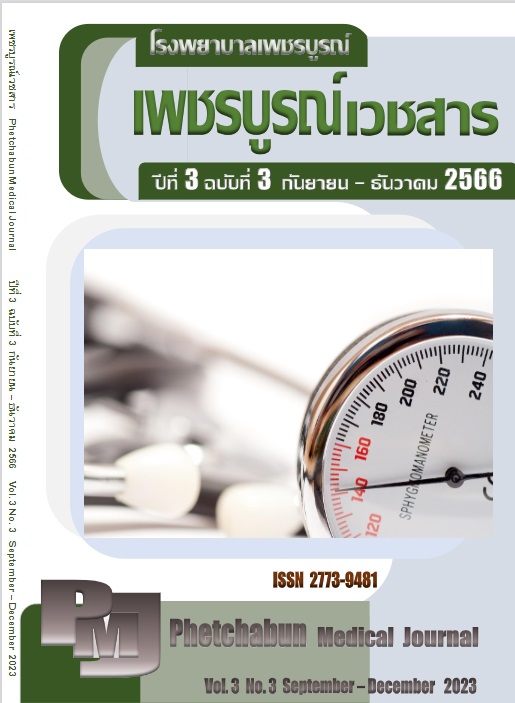Salty levels in dietary for inpatients prepared by the Nutrition department at Phetchabun hospital
Keywords:
Low salt diet, Diabetic diet, Regular diet, Salinity levelAbstract
The salt level in food is a critical factor influencing the occurrence of illnesses. This research aimed to study the salt level in dietary for inpatients prepared by the Nutrition department, Phetchabun hospital. The prospective analytical research design was conducted and measured the salt level in samples that were dietary prepared by the Nutrition department. The food was categorized into two types: boiled and stir-fried, and categorized further into three types for each including low salt, diabetic, and regular diets, with 62 samples each, totaling 372 samples. Data were collected using a salt level record form and salt meter. The salt levels were measured in three levels including low salt, moderate salt, and high salt. Data were analyzed using frequency, percentage, mean, standard deviation, and chi-square test to compare the differences in salt levels in dietary. Statistical significance was set at 0.05.
The result found that the salt levels in boiled food, particularly low salt and diabetic diets were mostly at a low salt level of 96.4% and 74.2%, respectively. However, a regular diet mostly had a moderate salt level of 53.2%. Comparison of the salt levels in boiled food among three groups were significantly different (p<0.001). For stir-fried food, the majority of low salt diet had a low salt level of 50.0%, diabetic diet had a moderate salt level of 64.5%, and regular diet had a high salt level of 61.2%. The salt levels in stir-fried food among three groups were also significantly different (p<0.001). However, comparing the salt levels between stir-fried and boiled food in low salt, diabetic, and regular diets were not statistically significant differences (p>0.05).
In conclusion, low salt and diabetic diets mostly have low salt levels aligning with the hospital's inpatient dietary standards, while regular diet has a moderate salt level. The study results should be used as a guideline for developing and improving hospital inpatient diets by ensuring that the salt levels in all diet types prepared by the Nutrition department are regularly verified

Downloads
Published
How to Cite
Issue
Section
License

This work is licensed under a Creative Commons Attribution-NonCommercial-NoDerivatives 4.0 International License.


